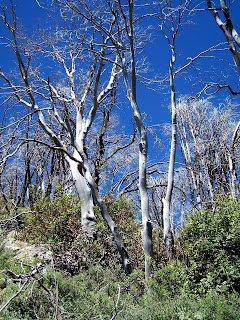
The landscape surrounding Tucson, those brackets of rugged mountains rearing out of this valley of stone and sand, is key to the essence of this part of the Sonoran Desert. We orient ourselves by them, learning early on their shapes and proximities -- the Catalinas to the north, the Tucsons to the west, the Santa Ritas to the south, and the Rincons to the east. We bid them a fond adios when we leave town, and they are the first to welcome us upon our return. We watch the light play over them, changing with the time of day and day of the year. We drive up into and over them, and test our legs and lungs by hiking them.
In the triple digit heat of the summer we retreat to the loftiest ones where the temperatures are guaranteed to be 20 degrees cooler, maybe more. Mt. Lemmon, soaring to over 9,000 feet in the Catalina Mountains, 6,500 feet above the Tucson Valley floor, is known as a "sky island", an ecosystem isolated by surrounding terrain, in this case a searing desert. You start your journey in classic Sonoran desert vegetation -- the iconic saguaro cactus, ocotillos, and palo verde trees -- and in less than thirty miles you you arrive in an Alpine landscape similar to that found in southern Canada. About half way up the mountain the windows in the car go down and the A/C gets switched off, and the car fills with cool air bearing the scent of pine.
Yesterday we joined a Pima County Natural Resources, Parks and Recreation outing, a trip up Mt. Lemmon with geologist Bob Scarborough. I've loved physical geography and earth science since junior high, and evenually earned a degree in geography and almost (all but paper) a masters in earth science. I was lucky enough to have taken classes with Bob Scarborough before during my two attendances at the Audubon Society's excellent Institute for Desert Ecology held annually at Catalina State Park. I knew we were in for a treat.
 Fifteen of us caravanned up the mountain, making five stops along the way. Bob started out orienting us to geologic time with his "time stick", a fancifully painted representation of a big chunk of Planet Earth's existence. A consummate story teller, Bob spun the tale of the creation of our mountains in a way that had us making connections across topics ranging from geology to archeology to spirituality, with heavy doses of mystery and wonder.
Fifteen of us caravanned up the mountain, making five stops along the way. Bob started out orienting us to geologic time with his "time stick", a fancifully painted representation of a big chunk of Planet Earth's existence. A consummate story teller, Bob spun the tale of the creation of our mountains in a way that had us making connections across topics ranging from geology to archeology to spirituality, with heavy doses of mystery and wonder. Some favorite factoids:
The Tucson Mountains are the remnants of a huge volcano, one which spewed out about 800 times as much debris as the Mount Saint Helen's eruption.
Mt. Lemmon is capped with sedimentary shale that is a million years older than the granite it now sits on, and was formed when the continents nested together and a shallow sea covered the area that is now Tucson.
The U-shape of Ski Valley on Mt. Lemmon (yes, you can drive from Tucson to a ski area in less than an hour) is evidence that there was probably a glacier on Mt. Lemmon at one point.
Our trip included a picnic stop at the San Pedro Vista

and a hike on the Oracle Ridge Trail.


And it was about more than rocks. The discussions ranged, quite logically mind you, from types of rocks, such as the banded gneiss so representative of the start up Mt. Lemmon, to the eroded granite hoodoos, to the Clovis people and the stomach contents (refined cocaine) of 8,000 year old mummies on two continents. It made sense. Trust me. And do yourself a favor -- if you get a chance to attend a class or participate in a field trip with Bob Scarborough (he leads trips for the Desert Museum among many others), take it.

No comments:
Post a Comment